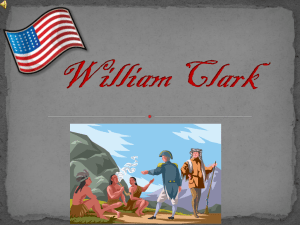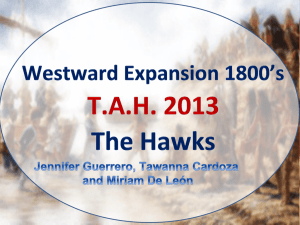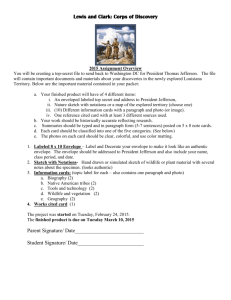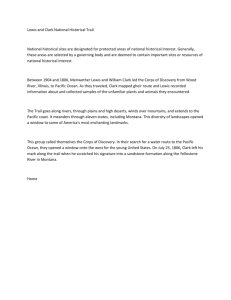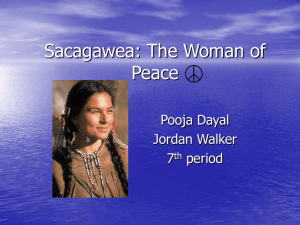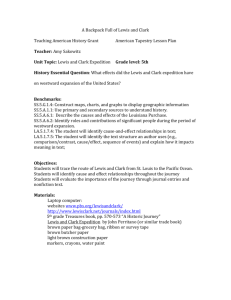lesson26.doc
advertisement
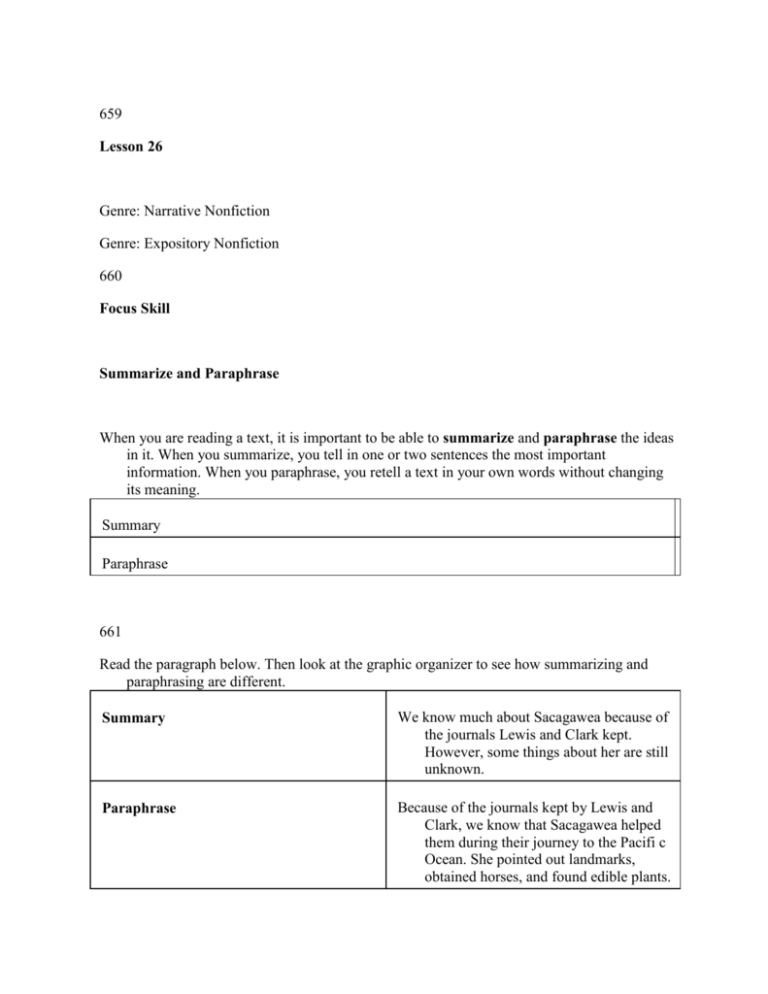
659 Lesson 26 Genre: Narrative Nonfiction Genre: Expository Nonfiction 660 Focus Skill Summarize and Paraphrase When you are reading a text, it is important to be able to summarize and paraphrase the ideas in it. When you summarize, you tell in one or two sentences the most important information. When you paraphrase, you retell a text in your own words without changing its meaning. Summary Paraphrase 661 Read the paragraph below. Then look at the graphic organizer to see how summarizing and paraphrasing are different. Summary We know much about Sacagawea because of the journals Lewis and Clark kept. However, some things about her are still unknown. Paraphrase Because of the journals kept by Lewis and Clark, we know that Sacagawea helped them during their journey to the Pacifi c Ocean. She pointed out landmarks, obtained horses, and found edible plants. However, the meaning of her name and how long she lived are mysteries. www.harcourtschool.com/storytown 662 Vocabulary Build Robust Vocabulary Pike’s Purposes peril terrain dismal esteem intently ordeal profusely asset Zebulon Pike was an explorer who faced peril willingly. He led expeditions to two parts of the Louisiana Purchase. The first expedition, in 1805-1806, was to find the source of the Mississippi River and establish American authority in the area. Pike and his group traveled nearly 5,000 miles over rugged terrain in dismal weather. Despite their efforts, they did not achieve their goals. Pike’s second expedition, in 1806-1807, was to explore the Arkansas and Red Rivers. Pike was also directed to enter Spanish territory and estimate troop numbers. American leaders came to esteem Zebulon Pike’s leadership abilities. They promoted him to general during the War of 1812. 663 In mid-November of 1806, Pike and his men found themselves in Colorado at the base of the Rockies. Pike gazed intently at a mountain he called Grand Peak. It was later named for him—Pikes Peak. The mountain winter was a terrible ordeal. It snowed profusely. Then, in February, Pike and his men were captured by the Spanish and led into Mexico. While a captive, Pike observed Spanish troop movements. After he was set free, he reported his findings to his superiors. His information was an asset to American leaders. Pikes Peak in Colorado www.harcourtschool.com/storytown 664 Lewis and Clark 665 666 In 1803, President Thomas Jefferson doubled the size of the United States through an agreement known as the Louisiana Purchase. Then Jefferson decided that American explorers should make a journey through the Louisiana Territory, which stretched from St Louis, Missouri, to the Pacifi c. He enlisted Meriwether Lewis to lead a group called the Corps of Discovery. Lewis then selected William Clark to help lead the expedition. In 1804, Lewis and Clark began their journey from St. Louis. They traveled through the Great Plains and then stopped for the winter season. A trader and his wife, a Native American named Sacagawea (sak•uh•juh•WEE•uh), decided to travel with the expedition when it resumed its journey in April 1805 into territory never before seen by outsiders. Lewis considered the Mandan (MAN · duhn) Indians’ stories about huge bears to be fanciful tales until one of the explorers was chased by a grizzly bear. 667 The Great Falls of the Missouri River were a beautiful sight, but also were difficult to travel around. William Clark had perhaps the best eyesight of any crew member. On May 26, he saw the outline of a great mountain range to the west. In the next few days, all of the explorers could see the snow-covered Rocky Mountains on the horizon. The sight was inspiring as well as troubling. The explorers knew that they would have to fi nd a way to cross the incredible barrier. Before they could cross the Rockies, the Corps of Discovery faced the Great Falls of the Missouri River in present-day Montana. Here the river tumbled down a bluff that was as high as a modern six-story building. The roar of the water was deafening. Lewis called it, “the grandest sight I ever beheld.” But the waterfall meant that the explorers had to carry their boats and supplies up steep cliffs before they could set out again on quieter waters upstream. Traveling around the falls took the party twenty-four days, and left everyone exhausted. 668 Carrying her baby boy on her back, Sacagawea won the admiration of the crew. She carefully scanned the riverbank to fi nd edible roots and fruit. These foods provided a welcome relief from the customary diet of meat and water. And in the mountain country, the Missouri River became a crooked stream that split into many small tributaries. Sacagawea pointed out landmarks that she remembered from a journey as a slave child, and she helped the captains choose the correct river branches on which to travel. Soon the members of the party began to wonder why they had not yet seen any Shoshone (shoh•SHOH•nee) or other American Indians. They had seen signs of Indian settlement— hunters’ trails and abandoned campsites—but since they left the Mandan and Hidatsa (hee•DAHT•suh) villages, the Corps of Discovery had not encountered any other people at all. In mid-August, Meriwether Lewis, hiking ahead of the party with a few other explorers, came upon three Shoshone women and several children. Lewis had carried an American fl ag in his pack for just such a meeting. Sacagawea quickly proved to be a valuable asset to the expedition 669 The journals kept by Captains Lewis, Clark, and several members of their expedition have been compiled into many published accounts since the journey ended in 1806. He waved the banner and walked slowly toward the group. One of the children fl ed. The women sat very still as if frozen with fear. Lewis explained that he was an explorer, and the women led him to their village. The Shoshone were a small tribe who were almost always at war with their powerful neighbors, the Blackfeet. They had never seen white people, but constant warfare made the Shoshone suspicious of all outsiders. Lewis hoped to buy horses from the tribe. Now that the rivers had all but disappeared, he needed horses to cross the peaks of the Rocky Mountains. But the chief, Cameahwait (kuh•MEE•uh•wayt), would not part with any of the animals. Lewis did persuade Cameahwait to send a few Shoshone to fi nd Clark and the rest of the party and bring them to the village. 670 The next morning, Clark and the others arrived at the village, and a meeting was held with Chief Cameahwait. Sacagawea prepared to serve as the translator. When the meeting began, Sacagawea stared intently at the chief. Then she broke into tears of joy. Lewis wrote, “She jumped up, ran, and embraced him, and threw her blanket over him, and cried profusely.” Sacagawea recognized Cameahwait as her brother, whom she had not seen in six years. Cheers and laughter rose from the village. The Shoshone hailed Sacagawea as a lost daughter who had come home. On September 1, 1805, the Corps of Discovery left the Shoshone territory. Chief Cameahwait not only provided the party with horses, he also gave them a guide to show them the best route through the mountains. Crossing the Rockies proved to be a difficult ordeal. The trails were too rugged to ride on, so the party walked and used the horses as pack animals. The expedition crossed the Rockies on foot, using the horses to carry their equipment and supplies. 671 In mid-September, a blinding snowstorm struck. Even the Shoshone guide got lost. Worst of all, the once-abundant wild game could not be found on the high mountain peaks. The explorers were forced to kill some of their pack animals for meat. The explorers’ journals report that the men laughed out loud when they fi nally crossed the mountains and reached grasslands on level terrain. The Lewis and Clark expedition emerged from the Rocky Mountains into the lovely valley of the Clearwater River in present-day Idaho. The waters were so clear that the river bottom and schools of fi sh were visible despite the river’s depth. In the Clearwater country, Lewis and Clark abandoned their pack horses and built new canoes. They reasoned that the streams on this side of the Rockies would all eventually flow into the Columbia River, the major river of the Pacific Northwest. American Indians called the Columbia River the Ouragon or Origan. The land around it was later called the Oregon Territory. Upon reaching the Clearwater River Valley, the expedition built new canoes to continue their journey west. 672 Traveling the rivers, the voyagers met the Nez Perce (NES PURS) Indians, who taught them valuable techniques for building and sailing log canoes. Less friendly were the Chinook (shih•NOOK) who drove hard bargains when trading for goods. But encountering the Chinook meant that the Pacifi c Ocean was not far away. One of the Chinook wore a black navy coat that he may have bought from a North American or European sailor. The explorers experienced some diffi culty in dealing with the Chinook Indians, but their encounter brought signs that the Pacifi c Ocean was near. A dismal rain pelted the travelers in early November as they sailed down the Columbia River. They made a camp near an Indian village and spent a restless night. On the morning of November 7, 1805, the rain stopped and the fog cleared. A chorus of shouts suddenly went up from the camp. William Clark scribbled in his notes, “Ocean in view! O! the joy.” On the horizon, still many miles to the west, lay the great Pacifi c Ocean. Upon seeing the ocean, some of the explorers wept, and others said prayers of thanksgiving. 673 But arriving at the Pacific Ocean did not end the Lewis and Clark expedition. The party still had to return home to St. Louis. President Jefferson had provided Meriwether Lewis with a letter of credit guaranteeing payment to any ship captain who would take the explorers to the eastern coast. The party made a winter camp at the mouth of the Columbia River near present-day Astoria, Oregon, and kept a watch for ships. No vessels were spotted. Finally, on March 23, 1806, the crew broke camp and began the long trek east toward St. Louis. To the explorers, the six-month return journey seemed to be easier than their fi rst journey because they knew what to expect in the river and mountain country. When the crew reached the Mandan village, they said good-bye to Sacagawea and her husband and continued back to St. Louis. On September 23, 1806, the Lewis and Clark expedition arrived safely back in St. Louis, Missouri, where their journey had begun more than two years earlier. The travelers had gone a distance of just less than 4,000 miles (6,400 km) from St. Louis to the mouth of the Columbia River and back. But the twisting rivers and mountain trails meant that the Corps of Discovery had actually covered about 8,000 miles (13,000 km) on the history-making trip. Throughout the explorers’ travels, they encountered more than fi fty American-Indian tribes. Sacagawea is remembered as a vital reason for the success of the Lewis and Clark expedition. This statue of Sacagawea stands in Bismarck, North Dakota. 674 The explorers saw the Pacific Ocean for the first time near present-day Astoria, Oregon. Jefferson’s letter of credit survived the journey west, but it was never used because the explorers returned home overland, instead of by ship. 675 The expedition returned with numerous samples of plant and animal life that had never before been seen by American scientists. Before the expedition, President Jefferson had hoped that the explorers would find a broad river that ships could use to sail directly to the Pacific Ocean. Lewis and Clark failed to find such a river, and the expedition was final proof that an inland waterway in North America did not exist. From St. Louis, Lewis and Clark traveled to Washington, D.C. Almost every town they passed through brought out bands to welcome them as heroes. In Washington, D.C., the explorers delighted President Jefferson with tales of grizzly bears and high mountain passes. The president said, “Lewis and Clark have entirely fulfi lled my expectations ... The world will find that those travelers have well earned its favor.” To Meriwether Lewis and William Clark, the mission itself was their greatest reward. Traveling through virtually unexplored lands was an exhilarating experience that they would cherish for the rest of their lives. Although they faced many dangers, the thrill—not the peril—of the expedition bursts from the pages of the journals they kept. As Lewis wrote the day he left the Indian village to enter the Western wilderness, “I could but esteem this moment of my departure as among the most happy of my life.” The Lewis and Clark expedition is commemorated by many historic sites along the route the explorers traveled. 676 Think Critically 1 What did President Thomas Jefferson hope Lewis and Clark would find on their expedition? What discovery did they make instead? NOTE DETAILS 2 How was crossing the Rockies a challenge for the Corps of Discovery? SUMMARIZE AND PARAPHRASE 3 Why do you think the author quoted Lewis and Clark directly in different parts of the selection? AUTHOR’S PURPOSE 4 What would be a worthwhile expedition for a group of skilled people to go on today? Would you be willing to be a part of this expedition? Explain. EXPRESS PERSONAL OPINIONS 5 WRITE Write a newspaper article about the Corps of Discovery as if you were a journalist writing on the day the expedition returned to St. Louis, Missouri. In your article, use details and information from the selection. SHORT RESPONSE 677 About the Author R. Conrad Stein R. Conrad Stein has published more than eighty books for young readers. Many of them are biographies or focus on history. Mr. Stein believes that his job as a writer is to express the drama of historical events. Born and raised in Chicago, he knew from the time he was twelve years old that he wanted to be a writer. After serving as a Marine, he studied history at the University of Illinois. A few years after he graduated, his background in history helped him get assignments writing history books for young readers. www.harcourtschool.com/storytown 678 Hupa and Yorok Baskets Social Studies Expository Nonfiction 679 Imagine living in a time and place when you could not go to the store to buy the things you need. Look around you. What could you use to make everyday things, such as plates, bowls, and pans? The Hupa and Yurok American Indians, who live in the mountains of northern California, are very good at using the trees, plants, and grasses around them to make useful and beautiful baskets. Long ago, basket makers spent much of the year collecting materials. In April and May, they collected hazelnut sticks to make the bases of their baskets. All year, weavers gathered roots to make the horizontal weave of the baskets. During the summer, weavers gathered materials to decorate their baskets. They might use bear grass to make light-colored patterns or maidenhair ferns to make dark patterns. Bark, roots, and rotten acorns were all used to make dyes for the baskets. The most talented weavers even wove porcupine quills into their designs. The Hoopa Valley, in California HOOPA VALLEY SAORAMENTO CALIFORNIA 680 Weavers followed simple steps to make a basket. First, they wet their materials to make them fl exible. Then, they used hazelnut sticks to make the base of the basket. Next, they built the basket by twisting together strands of grasses, ferns, and twigs. They continued to weave until the basket was as wide or as tall as they wanted. Many of these techniques are still followed today. Sometimes basket makers combined strands of dyed grasses with natural ones. The weavers created patterns by using the different colors. The patterns often represented nature or values, such as friendship. Weavers today still use many of these patterns in their baskets. bear grass 681 Besides being beautiful, the baskets were also useful. Skilled basket makers could weave so tightly that their baskets could hold water. Weavers made baskets for storing acorns, serving food, and drying fi sh. They also made basket hats, cradles, and baby carriers. Today, the Hupa and Yurok people continue to make baskets. People around the world collect the baskets, and weavers are well paid for their work. More importantly, making baskets is a way for the Hupa and Yurok to remember their heritage and keep their traditions alive. Traditional Native Basket Patterns of Northwest California Friendship Double Snake Nose Sharp Tooth Spread Hand Obsidian Blade Sturgeon Back Snake Nose Snake Obsidian Blade with Worm Trail Basket patterns often refl ected values or a love of the natural world. Can you tell why these patterns are named as they are? 682 Connections Comparing Texts 1. Would you have been a good member of Lewis and Clark’s expedition? Why or why not? 2. How are the genres of “Lewis and Clark” and “Hupa and Yurok Baskets” alike? How are they different? 3. What did you know about the Lewis and Clark expedition before you read this selection? What did you learn from the selection? 683 684 Reading-Writing connections Analyze Writer’s Craft: Narrative Nonfiction Narrative nonfiction gives facts and information about a topic. It may include headings, diagrams, photographs, and captions. When you write narrative nonfiction, you can use the work of authors such as R. Conrad Stein as writing models. Read the paragraph below from “Lewis and Clark,” and notice how the author organized his ideas. 685 Research Report A research report is a type of expository nonfiction. It gives facts and information about a topic. A research report includes a list of the books, articles, and online sources in which the writer found the information. As you read this research report written by a student named José, notice the text features and text organization José used. 688 Now look at what José did to prepare to write his research report. Notes José used note cards to write down information from a variety of sources. He made a new notecard for each important idea and included the source for each note. 689 Outline Then José created an outline to show the order of ideas he would follow as he wrote his report.
